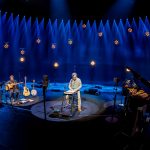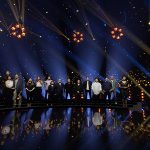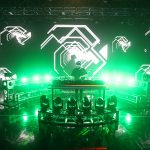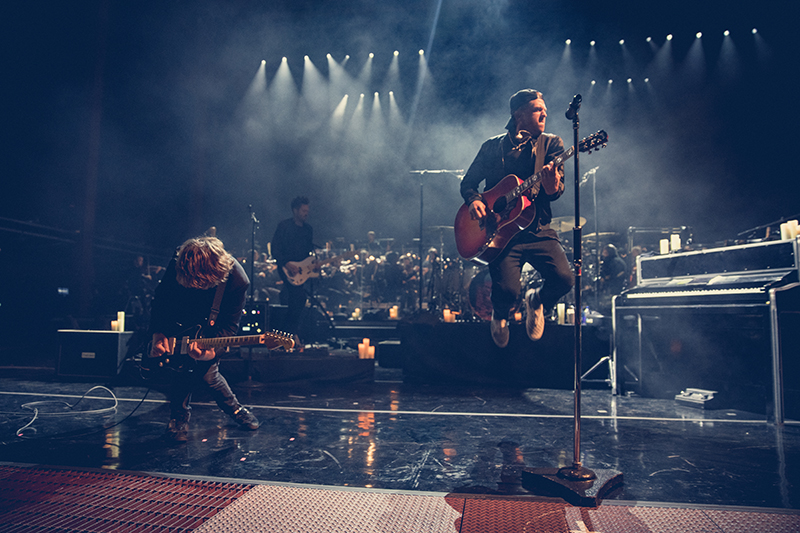
From time to time, the stars align to create interesting opportunities. Last summer, two of my clients decided to invite the entire Colorado Symphony Orchestra (CSO) to join them onstage for their summer performances at Red Rocks Amphitheater outside of Denver. As luck would have it, the shows were scheduled in the last week of August, with OneRepublic playing back-to-back nights followed by an evening with Josh Groban.
Josh’s touring show already included a 15-piece orchestra and 20-person choir, so musically, the CSO would simply flesh out the arrangements that were already part of the touring performance. OneRepublic would incorporate the symphony in their show from the ground up. Adding the symphony would lead to a complete rearrangement of songs the band regularly plays, and the addition of completely new pieces to a set list unique to this performance.
Just to make this more challenging, cinematographer Christian Lamb was tapped to bring ten cinematic cameras to capture the two OneRepublic performances for a documentary film. Christian has directed several of the band’s videos and could not resist the opportunity to capture this concert experience for future audiences.

A Special Venue
Anyone who has seen a show at Red Rocks might use words like beautiful, breathtaking and unique to describe the amphitheater. Anyone who has worked a show there as part of a visiting production might use some different, less flattering words to describe the load-in and load-out. Red Rocks has a long history of memorable performances by artists of all genres. One cannot help but be inspired by the sight of the massive rocks to the left and right of the seating area and of “Stage Rock” which sits directly upstage as the most obvious backdrop to any show.
The schedule and overall design requirements for these two performances indicated early on that it would be a benefit to both productions to share certain resources. One lighting and set design that could accommodate both performances would eliminate load-out and load in of those elements, thus saving labor costs. Each production simply needed to add their touring backline to the shared staging. A common P.A. would also hang for both of these shows. The CSO has their own audio team to mic up the orchestra, so their FOH console would be set up for all three nights.
Did I mention that all of this was to be done with no access to the venue prior to the shows? The earliest our load-in could be scheduled was 6 a.m., day of show. Pre-visualization was therefore essential, and the strategy of sharing resources could be applied to the design phase. We would require an accurate CAD model of Red Rocks, complete with rocks, roof, stage and audience seating. The Red Rocks Production Guide, which is made available to touring productions, includes a scaled floor plan that was drawn before I was born. Vectorworks makes it easy to scale such a PDF on a layer of the CAD model to provide a two-dimensional reference plan. Using illustrations of the roof grid and photos of the venue, I was able to piece together a 3D representation of Red Rocks that would be suitable to make design decisions and pre-visualize a fairly accurate lighting focus.

Orchestral Layout
When you tackle a symphonic collaboration, you soon learn that orchestras don’t like to do “different.” Working with Josh, I have found that the small group of orchestral players we hosted at each show weren’t too fussy and could be re-arranged to modify the visual aesthetic. Our guitar player acted as music director and might face the orchestra in order to conduct a certain difficult passage or ending of a song. As long as he had an unobstructed view of the first violin, we could move the players to accommodate changes in set design or microphone placement.
This approach would not play so well with the entire CSO. A Google search of “orchestra layouts” returns numerous floor plans for a “typical symphony.” Cross-referencing them reveals some common practices: First violins are stage right side of the conductor, basses stage left, horns and percussion upstage, etc. I had the ambitious plan to elevate the orchestra on four separate riser arrangements. During a conference call between touring and CSO production managers, we learned exactly how much bowing space was needed for a violin player, and that the plan, as drawn, would not work. Symphonies, as it turns out, are used to being placed mostly on the floor, with some of the brass players and percussion elevated on small risers. Having opened with a bold structure that would definitely not be approved, I listened carefully to the CSO in order to understand their needs and priorities. They approved one massive riser with four different levels.
Josh’s touring lighting design already covered six band positions and a small orchestra, so I began with that. The first task was to augment the orchestra lighting to accommodate their increased numbers. The second task would be to light up the rocks and architecture at Red Rocks. I have noticed that photos of past performances at this venue often show the rocks lit up while the curved brick structures on either side of the stage are neglected. I added fixtures to turn the buildings themselves in to set pieces. Stage Rock was covered by two banks of wash fixtures. Fixtures were placed on the spot booth roofs to augment the venue’s ETC Lustr fixtures that light up the rocks on either side of the audience.

Building on the “Kernel”
To cover touring band members, there were groups of front and back lights within both the OneRepublic and Josh Groban touring lighting plots. All of my designs are based on the idea of a “kernel” of the show that is programmed by specific primary task assigned to each automated light. Some of these moving lights never move — and that’s okay! A “base” cue running in the background serves as the primary focus for all of the lights, including beam size. The first cue of any song sequence can override these positions to create a different look. However, with only the “base” cue active, one should be able to bring up every light in the rig at once and see everything in the environment that needs to be seen, lit up tastefully.
I therefore simply needed to make sure that the plot would meet the needs of both artists. Each show file contained layers for Audience, Keylight and Backlight, whose names are self-explanatory. Other layers with names like “General Wash” and “Aux Profile” lay down textures that cover broader focus areas. One can clone from this “kernel” to the most massive festival rig, or reduce it to the bare essentials.
With lighting and staging elements in place for both shows, rocks and architecture had to be added to the programming. A low intensity look would play from house lights to the end of the show and between each song. Each show has a very specific color palette which the architectural lighting could establish as the fans walked into the theatre. With a base look now established, I could go through, song by song, and bring the rocks to life. As the audience became accustomed to this background, the occasional total blackout or other effect on the rocks would be that much more dramatic.
The next programming task would be to consider the orchestra fixtures. In Josh’s show, this meant cloning to additional fixtures to accommodate more players, whereas the OneRepublic show needed a whole new orchestral treatment. As the band was already considered in the show kernel, this was simply a process of adding orchestra lighting to cues that were already in the show file.
There needed to be different elements in addition to the change of colors on the rocks to make each artist’s environment unique. The orchestra risers were left un-skirted for OneRepublic allowing floor lights to shoot through the gaps between, casting interesting shadows and rays through the players. For Josh Groban’s performance, these gaps were blacked out and we hung our simple backdrop comprised of surgical tubes stretching from floor to truss to suggest a bridge’s suspension wires.

Lighting the Venue Itself
Although the programming had been done before arriving at the venue, it was quite a process to dial in the detail to make both shows spectacular. I enlisted the help of an old friend, Jeff Farrow, to assist at FOH. On the day, there always seemed to be another detail that needed attention. Jeff had the patience to figure out how to clone to the venue’s architectural Lustr fixtures, which use different color control channels than your standard RGBW. He also tweaked the focus on the rocks after the show began, as we had no dark time before the first show. During the show, he had a video monitor and a page of inhibitive submasters to adjust the relative levels of various groups of lights for the cameras. This allowed me to run the show as programmed without having to worry about exposure for the OneRepublic concert film.
Our systems designer Tim Solar took the Vectorworks model and worked his own magic on it, adding everything down to the last data cable to generate his pull lists for the Christie Lites shop in Vegas. His process generates “truss tapes,” which are familiar in the theater world but seldom used in touring, where pre-rigged truss is the norm and there is time to label the fixture hanging locations with colored tape. These paper scrolls sped up the shop prep, and the lighting rig rolled easily and quickly into Red Rocks, as if we had been on tour for months.
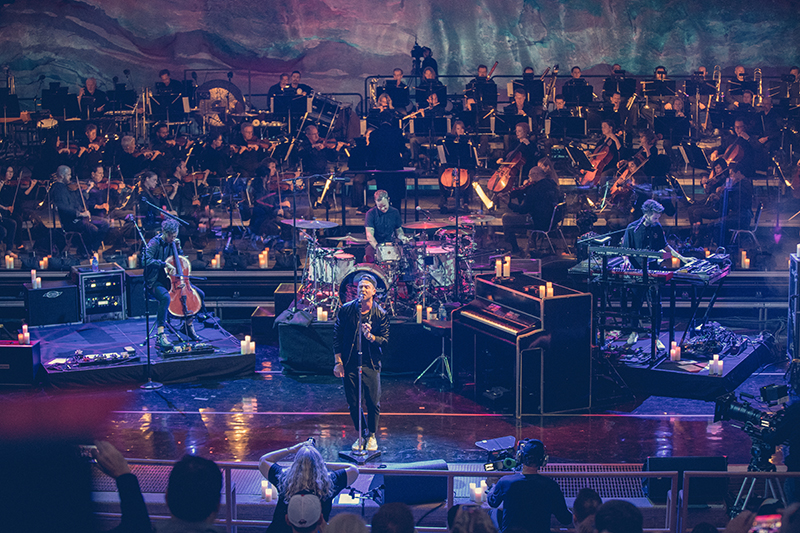
Showtime!
We finally came to that moment that always comes, no matter how extensive your planning, programming or preparation: House Lights! Show! Here we go! While the members of OneRepublic hail from all over the country, they recorded their first two albums in Denver and have always been welcomed there as a hometown band. Our two nights at Red Rocks were no exception, and the sold-out crowd poured their energy down that long slope of stone seating right on to the stage, where the band and the orchestra consumed, amplified and returned the energy to the audience. We were simply along for the ride to make it look good and augment dramatic moments in the music. The band was on fire, and the venue was completely alive!
Josh’s show brings with it a different, yet similarly intense energy. When you look up at the audience from the stage at Red Rocks, the crowd is right in your face, stacked on each other all the way to the top of the 380 steps. The stage itself is not raised, so the artist is always looking up to see their fans. This is a unique perspective that exists in few venues. The symphony fleshed out the existing orchestral arrangements, making this show magical in its own way. The inspiration was evident on Josh’s face as he filled the mile-high amphitheater with his operatic voice.
It’s an honor to be trusted with the visual presentation of two major talented and diverse artists. The experience of mounting two different productions in three days at one of the most beautiful and revered venues in the world will always be a highlight of my career. To make any of this happen, four separate teams had to work together: the Josh Groban touring crew, the OneRepublic touring crew, the CSO and the promoter that saw the benefit of sharing resources between the two shows. Quite a number of talented people gathered in this special place for three days in August to give the Denver audience a night to remember.
A. J. Pen is production designer for OneRepublic and Josh Groban.
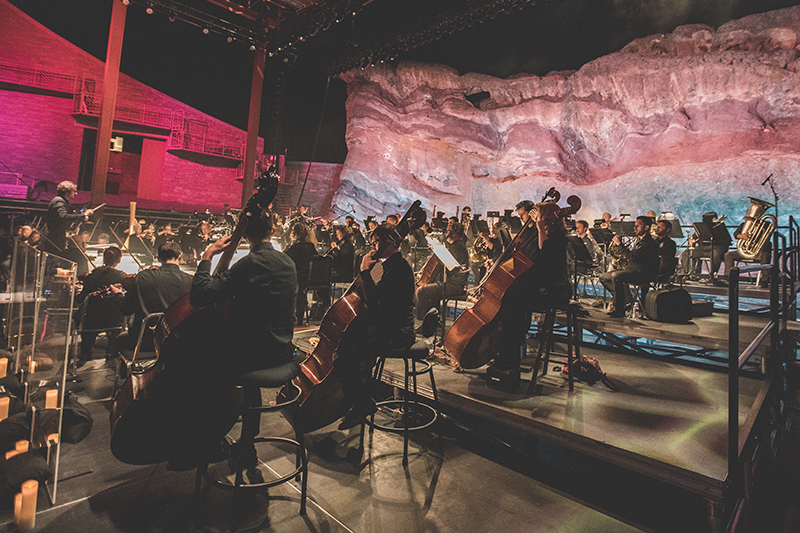
OneRepublic and Josh Groban with the Colorado Symphony
Red Rocks Amphitheatre, Morrison, CO, Aug. 2019
Crew
- Lighting Co: Christie Lites Ltd.
- Production Designer: A. J. Pen
- Lighting Crew Chief: Tim Solar
- Assistant LD: Jeff Farrow
- Lighting Crew: Will Anglin, David Shulman, Timothy Olson
OneRepublic Touring Crew:
- Production Designer: A. J. Pen
- Production Manager: Dave McMullin
- Assistant Production Manager: Anne Kallevig
- Tour Manager: Mark Oglesby
- Assistant Tour Manager: Sators
- Stage Manager: Andy Figueroa
- Musical Director: Brandon Collins
- Assistant Musical Director: Paul Nelson
- Playback: Drew Chaffee
- FOH Audio Engineer: Justin Ripley
- Monitor Audio Engineer: Dave McMullin
- Audio Tech: Justin Pader
- Backline Drums: Chris Wong
- Backline Stage Right: Riley Emminger
- Backline Stage Left: Josiah Ronco
- Security: Dustin Folkes
- Security: Mike Faello
- Video Director: Charles Signaigo
- Production Coordinator: Casey Gill
Josh Groban Touring Crew:
- Production Designer: A. J. Pen
- Production Manager: John Lafferty
- Tour Manager: Britton Billik
- Production Coordinator: Wendy Wilson
- Stage Manager: Gregory Dean
- FOH Audio Engineer: Marlow “Mickey” Beck
- Monitor Audio Engineer: Adam Robinson
- Audio Monitor Tech: Thomas “Chip” Valentino
- Audio FOH Tech: Michael Mordente
- Audio Tech: Brett
- Lighting Crew Chief: Kitty Hoffman
- Lead Carpenter: Carl Young
- Carpenter: Rob Saldate
- Playback: Jorge Vivo
- Backline Drums, Percussion: Nissim Aharon
- Backline Guitars: Trevor Cole
- Backline Keyboards: Will Jennings
- Backline, Prompter: Jeff Butler
- Security: Zachary Singer
Gear
- 2 grandMA2 Full consoles
- 74 Martin MAC Quantum Profiles
- 62 Martin MAC Quantum Washes
- 92 Elation ZW19’s
- 10 GLP Impression X4 Bar 20’s
- 2 Robe RoboSpot BMFL’s
